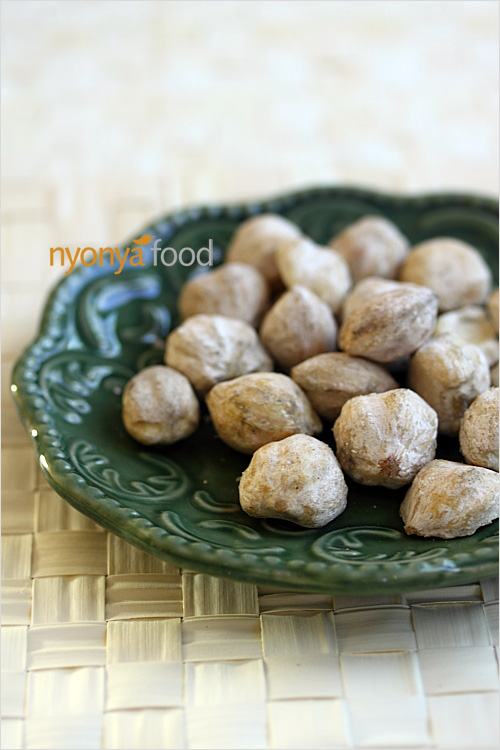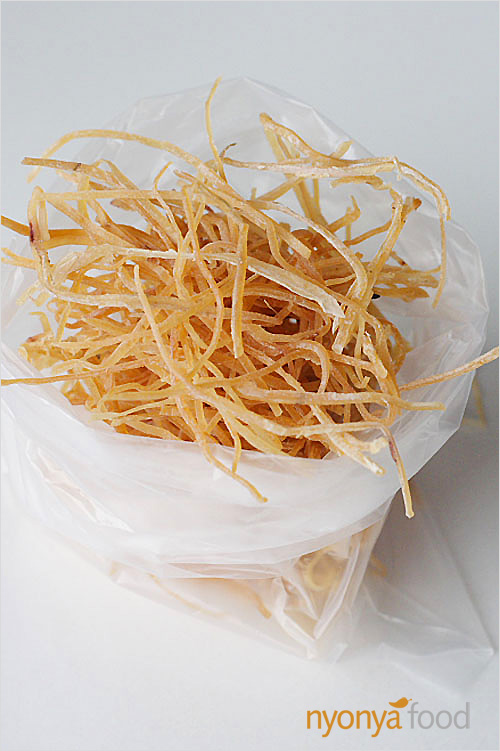
Many readers emailed and asked about candlenuts or buah keras when I posted the Udang Masak Lemak Nenas recipe by Nyonya Pendek Melaka.
An important ingredient in Nyonya (and Indonesian) cooking, this post serves as a brief introduction of candlenuts, or buah keras in Malay, or kemiri in Indonesian. On the packaging of candlenuts, you will mostly see the above three names: candlenuts, and kimiri, as most candlenuts found here in the United States are made in Indonesia…
Click to Read More →
Bunga Kantan (Ginger Flower/Torch Ginger Bud)
by Nyonya Food on October 20, 2009 · 39 comments
in Ingredients
◄ Back
Next ►
Bunga Kantan (Ginger Flower/Torch Ginger Bud) pictures (1 of 4)
Click the image to see next picture
Bunga Kantan is the soul of many Nyonya dishes—Assam Laksa, Nyonya fish stew and curry dishes such as perut ikan and gulai tumis. Bunga kantan is another Nyonya ingredient that I can’t find here in the United States.
Bunga kantan, or in English, ginger flower or torch ginger bud is the bud of red ginger plant. (There are a few types of ginger: yellow, blue, and red.) Pinkish in color, they look very pretty and smell great, and they are usually halved lengthwise and used in curries and stews. When cooked, bungan kantan imparts an impossibly floral fragrance and exotic aroma into the dishes. For Assam Laksa, the bud is sliced finely as part of the toppings that complements the sour fish broth and laksa noodles…
Click to Read More →
Pandan Leaf (Screwpine Leaf)
by Nyonya Food on September 14, 2009 · 10 comments
in Ingredients
If you are not familiar with Southeast Asian cuisines, you might not have seen or heard of pandan leaf or screwpine leaf. Known as “the vanilla of the east,” pandan leaf is an indispensable ingredient in many Nyonya recipes, especially when it comes to Nyonya desserts and sweet cakes known as Nyonya kuih.
My next post is about a favorite Nyonya kuih where pandan leaf is the main ingredient so this post serves as a quick introduction…
Click to Read More →
Nyonya Ingredients: Jiu Hu See (Shredded Cuttlefish)
by Nyonya Food on September 3, 2009 · 5 comments
in Ingredients

Jiu hu see, or shredded dry cuttlefish is mostly used by Nyonyas and Peranakan cooks to make jiu hu char, a vegetable dish flavored with dried cuttlefish. In Hokkien dialect, “jiu hu” means cuttlefish, and “see” means thin threads. Other than making the signature jiu hu char, my mother often used jiu hu see to flavor her white turnip (daikon) soup. I love the briny taste of jiu hu see as it adds a very special depth and a pleasing “fishy” note to soups and vegetables.
I have never seen jiu hu see in any Asian stores in the United States. A whole dried cuttlefish is a great substitute. All you have to do is shredding it up to thin threads and you can use them to make your desired dishes…
Click to Read More →




